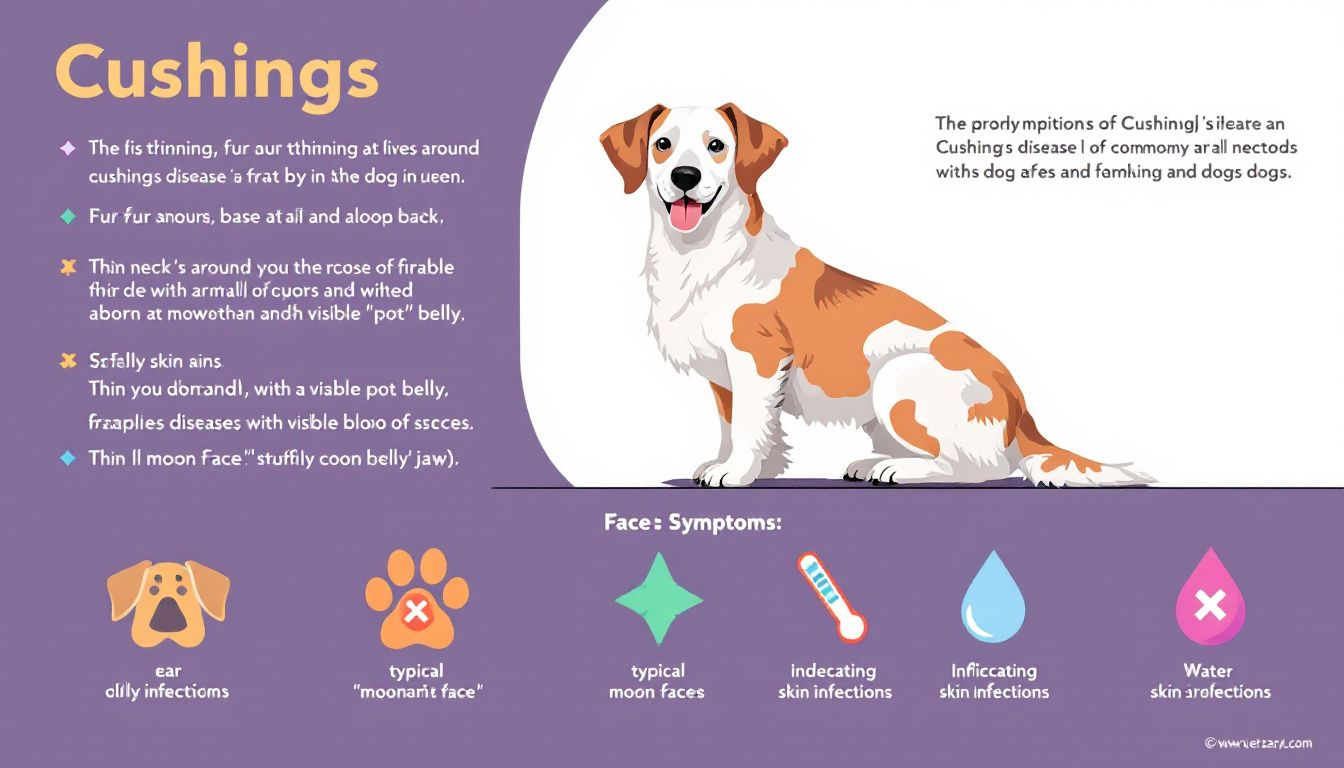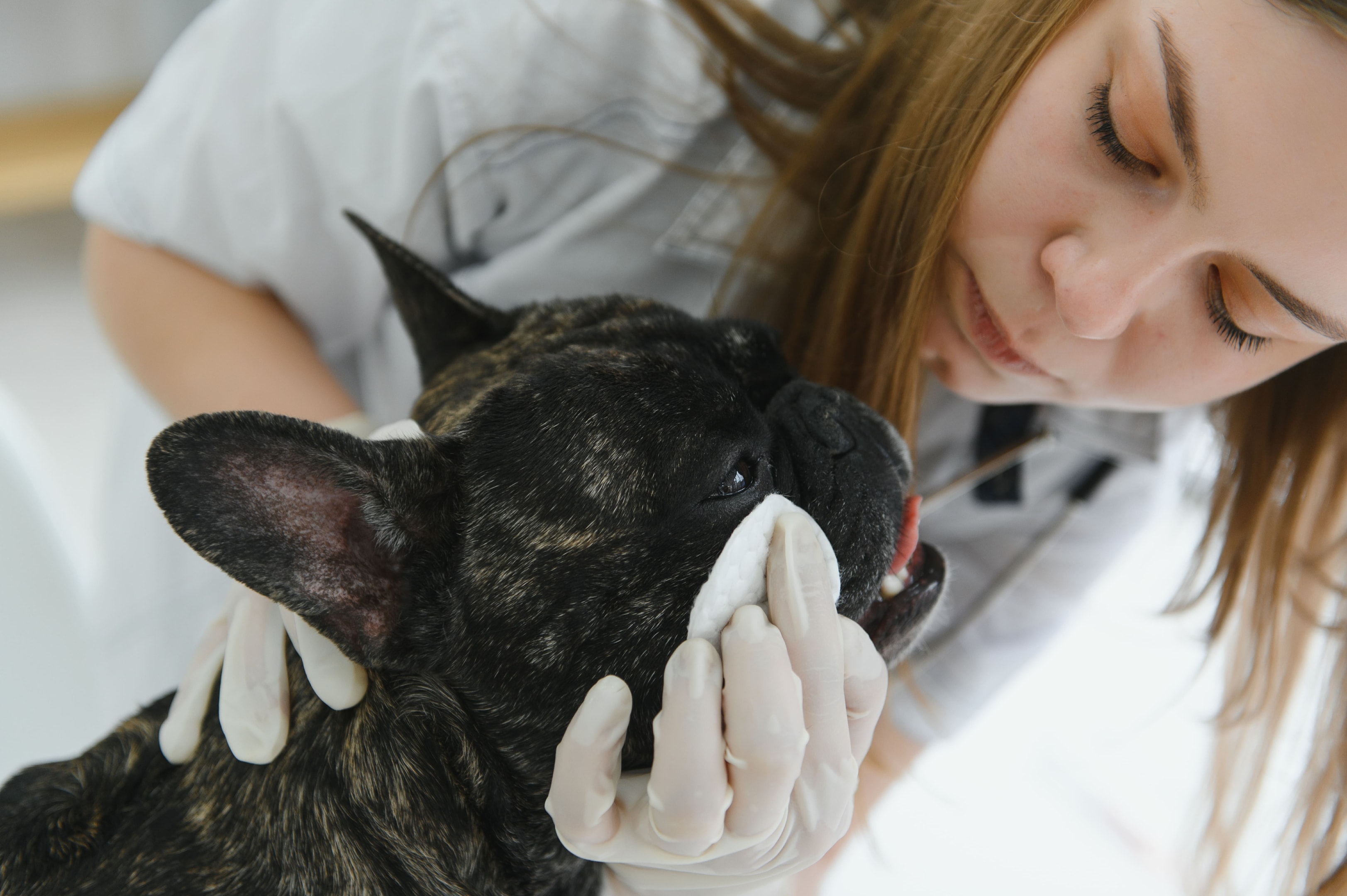Recognizing and Managing Cushing Disease in Dogs Symptoms

Cushing disease in dogs causes the adrenal glands to produce too much cortisol. Learn about the common symptoms of Cushing’s disease in dogs symptoms, such as excessive thirst, hair loss, and muscle weakness. Early detection is key to improving your dog’s health. This article covers everything you need to know about Cushing disease symptoms in dogs.
Key Takeaways
- Cushing’s disease in dogs is characterized by excessive cortisol production, primarily caused by tumors in the pituitary or adrenal glands, affecting older dogs and certain breeds more than others.
- Common symptoms of Cushing’s disease include excessive thirst and urination, increased appetite, hair loss, muscle weakness, and skin problems, which necessitate early veterinary intervention for effective management.
- Diagnosis involves physical examinations, blood tests, and imaging techniques, while treatment options include medications, surgery, and radiation therapy, all requiring ongoing monitoring and adjustments to enhance the dog’s quality of life.
Understanding Cushing’s Disease in Dogs

Dogs Cushing’s disease, also known as hyperadrenocorticism or hypercortisolism, is a condition where the adrenal glands overproduce cortisol, a hormone essential for stress response, metabolism, and immune function. This overproduction leads to a cascade of health issues that can significantly impact a dog’s quality of life.
The primary causes of Cushing’s disease include abnormalities in the pituitary and adrenal glands that lead to excessive hormone production. This condition can affect various dog breeds, including Boston, Yorkshire, Bull, Silky, and Scottie Terriers, German Shepherds, Poodles, and Beagles, with certain breeds being at higher risk. Typically, Cushing’s disease affects older dogs, with an average diagnosis age of around 10-11 years old.
Early intervention and effective management hinge on understanding the nuances of Cushing’s disease. Timely recognition of clinical signs and seeking veterinary care can greatly impact your pet’s health and longevity.
Primary Causes: Adrenal Glands Overproduce Cortisol
Cushing’s disease in dogs is usually caused by tumors in either the adrenal gland or the pituitary gland. Most commonly, the condition stems from a tumor on the pituitary gland, accounting for approximately 85%-90% of cases. These tumors, often benign, lead to the excessive production of ACTH, which in turn stimulates the adrenal glands to produce excess cortisol.
In rarer instances, an adrenal gland tumor can be the culprit. These tumors can be either benign or malignant, leading to what is known as adrenal-dependent Cushing’s disease. Treatment for adrenal dependent Cushing’s disease often involves major abdominal surgery to remove any adrenal tumors, and successful removal can lead to a return to normal health for the dog. Diagnostic tests help differentiate between adrenal and pituitary-dependent Cushing’s disease, outlining the complexities of treatment. Regardless of the tumor type, the overproduction of cortisol results in the common clinical signs associated with the disease.
Types of Cushing’s Disease
There are two main types of Cushing’s disease in dogs: pituitary-dependent and adrenal-dependent. Pituitary-dependent hyperadrenocorticism is the most prevalent form, resulting from a benign mass on the pituitary gland that causes excess production of ACTH. This form of the disease leads to the pituitary gland secreting too much ACTH, which then prompts the adrenal glands to produce more cortisol, known as pituitary dependent cushing’s disease. Treatment can involve medications such as trilostane and mitotane, while surgery and radiation are potential but less common options due to complications.
Adrenal-dependent hyperadrenocorticism, on the other hand, is characterized by the presence of a tumor in the adrenal gland. This tumor directly causes the adrenal glands to overproduce cortisol, leading to the symptoms associated with adrenal dependent cushing’s disease. Treatment usually involves major abdominal surgery to remove any adrenal tumors, and successful removal can lead to a return to normal health for the dog. Determining the most effective treatment approach requires knowledge of these types.
Common Symptoms of Cushing’s Disease in Dogs
Early detection and management of Cushing’s disease rely on recognizing its symptoms. Common symptoms include excessive thirst and urination, ravenous appetite, loss of hair, muscle weakness, panting, skin problems, lesions on the skin, and a bloated or expanded belly. These symptoms can vary in intensity and may develop gradually, making them easy to overlook initially. Cushing’s syndrome can also present with similar symptoms.
Increased thirst and urination occur in 80-90% of dogs with Cushing’s disease. Additionally, excessive hunger, referred to as polyphagia, is a common symptom. Early recognition of these signs is key to timely veterinary care and improving your dog’s quality of life.
Symptoms of Cushing’s disease can mimic other conditions, so consulting a veterinarian for an accurate diagnosis is crucial. Early intervention can help manage the disease and reduce the risk of complications.
Increased Appetite and Thirst
One of the hallmark symptoms of Cushing’s disease in dogs is increased appetite and thirst. Dogs with this condition often experience a significant rise in hunger and water intake. This symptom, along with excessive production of urine, can be an early indicator of the disease.
If you are constantly replacing your dog’s water bowl and it seems as if they are going to the bathroom or having more accidents than normal, it may be time to start watching out for other signs. While this is not surefire evidence that your dog has the disease, it is one of the common symptoms of Cushing’s in dogs. Early detection and intervention can be achieved by monitoring these behavioral changes in your pet.
Changes in Appearance: Hair Loss and Weight Gain
Cushing’s disease can lead to noticeable changes in a dog’s appearance. Hair loss, often along the sides, belly, or tail, is a common symptom. In addition to hair loss, dogs with Cushing’s may develop thin skin and dark spots due to skin mineralization and changes in fat distribution. These changes can be distressing for both the dog and the owner.
Cushing’s disease can lead to many noticeable changes in a dog’s appearance, including:
- Hair loss, often along the sides, belly, or tail
- Thin skin
- Dark spots due to skin mineralization
- Changes in fat distribution
These changes can be distressing for both the dog and the owner. Weight gain and a potbellied appearance are also significant changes associated with Cushing’s disease. These physical signs, along with other symptoms, are often assessed by veterinarians during physical exams to help diagnose the condition. Early recognition of these changes can enhance treatment and management effectiveness.
Behavioral and Personality Changes: Low Energy
Behavioral changes are another critical aspect of Cushing’s disease in dogs. Affected dogs may show marked lethargy due to decreased energy levels. This lethargy, combined with prolonged panting, is often linked to their overall energy depletion. These changes can significantly impact a dog’s quality of life and daily activities.
Muscle weakness is also a concern, contributing to the overall lethargy and reduced activity levels seen in affected dogs. Managing the disease effectively and improving the dog’s overall well-being depend on recognizing these behavioral changes and seeking veterinary advice.
Hind Leg Weakness
The affected dog may experience muscular atrophy in the hind legs when suffering from Cushings, thereby decreasing hind leg movement and function. In this case, a joint support may be helpful. Veterinarians may recommend glucosamine or they might suggest a glucosamine alternative with added benefits (such as an eggshell membrane joint supplement).
Diagnosing Cushing’s Disease in Dogs: What Your Vet is Looking For

Even if your dog has one or more of these signs, there is a small chance that your dog is only exhibiting symptoms of Cushing’s and that they do not actually have the disease. It is very important to take your dog to the vet if these signs are present so you can be certain before making a diagnosis. Here are a few things vets look for:
- Blood Clots: One of the worrisome symptoms of Cushing’s in dogs is a penchant for blood clots that was not present before.
- High Alkaline Phosphatase Levels: This is one of the Cushings symptoms in dogs that requires testing. This often happens as a result of the increased cortisol levels. In many cases, blood sugar levels are also heightened.
- A Combination of all listed Cushing’s Symptoms in Dogs: If a dog exhibits multiple major warning signs of Cushing’s, there is a very high chance that the dog has Canine Cushings Disease.
- Increased Cortisol Levels: The most reliable indicator of Cushing’s in dogs symptoms is increased cortisol levels. This is the most direct analysis and almost always proves or disproves a diagnosis.
- Increased Sex Hormones: In atypical Cushings, cortisol levels may be normal, but sex steroids (such as estradiol, progesterone, and aldosterone) levels are elevated.
Ways to Test for Cushing’s Disease in Dogs
Physical Examination
The first step in diagnosing Cushing’s disease is a thorough physical examination by a veterinarian. During the exam, the vet will discuss your dog’s symptoms and any current medications. Pet owners should mention all relevant details since symptoms like increased urination can be linked to elevated cortisol levels affecting kidney function.
This initial examination sets the stage for further diagnostic testing.
Blood Tests and Urinalysis
Common diagnostic tests for Cushing’s disease include:
- Urinalysis
- Urine culture
- Blood panel
- Chemistry panel
- Adrenal function tests
The ACTH stimulation test and the low-dose dexamethasone suppression test are frequently used to diagnose the disease. Blood tests often reveal high cholesterol and triglycerides, alongside changes in white blood cells, providing crucial information for diagnosis.
A complete blood count may show a stress leukogram, elevated liver enzyme ALP, and protein in the urine. However, it’s important to note that adrenal function tests can yield false positives due to other diseases presenting similar symptoms. The low-dose dexamethasone suppression test is often preferred because it is typically the least expensive option. These tests help confirm the diagnosis and guide treatment decisions.
Imaging Techniques
Imaging techniques such as abdominal ultrasound, CT, and MRI are invaluable tools in diagnosing Cushing’s disease in dogs. An abdominal ultrasound may reveal the size of the adrenal glands and the presence of a tumor. MRI is often considered the most effective imaging technique for diagnosing Cushing’s disease, providing detailed images that help assess the condition.
These techniques are essential for identifying benign or malignant tumor and guiding treatment plans.
ACTH Stimulation Test
The ACTH stimulation test is a critical diagnostic tool for evaluating how well the adrenal glands respond to adrenocorticotropic hormone. In this test, healthy dogs typically show a marked increase in cortisol levels after hormone administration.
This test helps differentiate between types of Cushing’s disease and guides the treatment approach.
Treatment Options for Cushing’s Disease

Treatment for Cushing’s disease should be pursued when clinical signs affect the dog’s quality of life or to reduce complications. Common treatments include medications that reduce cortisone production and surgical tumor removal, which is the only real cure for the disease. Most cases are treated with medication rather than surgery due to the complexity and risks associated with surgical interventions. Surgical removal of an adrenal tumor can potentially lead to the dog regaining normal health, although it carries significant risks.
When evaluating treatment options, it’s important to consider the risks of surgery, side effects of medications, and financial constraints. Monitoring is essential to prevent complications that may arise from treatments. Managing a pituitary tumor, a primary cause of Cushing’s disease, often requires medications like trilostane and mitotane, and sometimes surgical or radiation interventions. Understanding these options allows pet owners to make informed decisions about their dog’s care.
Iatrogenic Cushing’s disease and iatrogenic Cushing’s syndrome result from the excessive administration of steroids, often required for other medical issues. Managing these conditions involves gradually discontinuing steroid use under veterinary supervision to mitigate recurrence of the original condition being treated. Awareness of these causes and potential health risks is crucial for effective management.
Medication Treatments
The preferred medication treatment for Cushing’s disease in dogs is Trilostane (Vetoryl®). Common medications used to treat pituitary-dependent Cushing’s disease include Trilostane and Mitotane, which help manage cortisol levels. Mitotane works by destroying part of the adrenal gland to reduce cortisol production.
Monitoring for side effects and adjusting dosages as needed is crucial. Medication treatments can be effective but require ongoing management and regular veterinary check-ups to ensure the dog’s health and well-being.
Surgical Interventions
Surgery is considered the only real cure for Cushing’s disease in dogs. Surgical intervention typically involves the removal of tumors associated with the disease. However, due to the risks and financial constraints, surgery is often not pursued.
When feasible, surgery can be pivotal in treating Cushing’s disease despite these challenges.
Radiation Therapy
Radiation therapy is a treatment option for dogs with pituitary tumors. This therapy targets and shrinks the tumor without the need for surgical intervention.
Other treatment alternatives for a pituitary gland tumor include surgery or radiation therapy, depending on the specific case and overall health of the dog.
Alternative Therapies
Treatment with melatonin has shown effectiveness in treating both typical and atypical Cushing’s disease in dogs. Flaxseed lignans have also been mentioned as a potential supportive therapy for Cushing’s disease. These alternative therapies can be considered in conjunction with conventional treatments to help manage the disease.
Managing Your Dog’s Health Post-Diagnosis
Effective management of Cushing’s disease often requires long-term monitoring and adjustments in treatment. Maintaining a consistent routine and providing emotional support are crucial for managing the condition and ensuring your dog’s quality of life. Detecting changes in symptoms and adjusting treatments require regular veterinary check-ups and monitoring.
Diet, nutrition, and regular monitoring are vital for managing your dog’s health post-diagnosis. If an adrenal tumor is successfully removed and is not malignant, there is a strong likelihood that your dog will regain normal health following the surgery. By staying vigilant and proactive, you can help your dog lead a comfortable and fulfilling life despite the challenges posed by Cushing’s disease.
Diet and Nutrition
A low-fat diet is typically recommended for dogs with Cushing’s disease. Flaxseed lignans and melatonin may be considered for their potential supportive roles in managing the disease, but they are not substitutes for conventional treatments.
A balanced diet and consistent exercise can greatly enhance the quality of life for dogs with Cushing’s disease.
Regular Monitoring
Adjusting medications and observing the dog’s health condition necessitate regular veterinary check-ups. Diligent observation can help minimize health issues in dogs with Cushing’s disease. Long-term management is also crucial in addressing these concerns. Careful monitoring and follow-up blood tests are important for ensuring effective treatment in dogs undergoing treatment for Cushing’s disease.
Dogs on trilostane should be monitored every three months for life to assess treatment efficacy. Dogs with Cushing’s disease require routine blood tests and medication adjustments throughout their lifetime.
Without adequate monitoring after treatment, dogs can face relapses, severe illness, or death due to complications.
Quality of Life Considerations
Maintaining a good quality of life for a dog diagnosed with Cushing’s disease is crucial, as the condition can lead to significant discomfort and changes in behavior. Quality of life assessments should be an integral part of managing the dog’s treatment plan, considering both physical and emotional well-being.
Symptom management through medications, diet, and regular vet check-ups can greatly improve a dog’s quality of life.
Prognosis for Dogs with Cushing’s Disease

The prognosis for dogs with Cushing’s disease varies based on the cause and related conditions. Untreated dogs often experience a deterioration in quality of life over time. However, effective treatment can significantly enhance a dog’s quality of life and decrease the risk of developing other health issues. The average survival time for dogs with pituitary-dependent Cushing’s disease treated with trilostane or mitotane is around 2 to 2.5 years.
Dogs treated for adrenal tumors may have an average survival time ranging from 1.5 to 4 years if surgery is successful. Radiation therapy is often used as an adjunct treatment for dogs with pituitary tumors when surgery is not an option. With proper management, dogs with Cushing’s disease can lead fulfilling lives.
Pituitary-Dependent Prognosis: Pituitary Gland Tumor
Dogs with pituitary tumors generally can live normal lives for many years with effective treatment. Management strategies can greatly enhance the quality of life for dogs with pituitary-dependent Cushing’s disease.
Adrenal-Dependent Prognosis
The prognosis for dogs with malignant adrenal tumors is considerably less optimistic compared to benign tumors. However, early detection and successful surgical intervention can improve the outcomes for dogs with adrenal-dependent Cushing’s disease.
Learn More about Cushing’s Disease in Dogs
For more comprehensive information on Cushing’s disease in dogs, visit Lignans.com. Discover how lignans and other supportive therapies can help manage the condition and improve your dog’s quality of life.
Frequently Asked Questions
What treatment has shown effectiveness for both typical and atypical Cushing’s disease in dogs?
Treatment with flaxseed lignans and melatonin has proven effective for both typical and atypical Cushing’s disease in dogs. This approach is a promising option for managing the condition.
What is the only real cure for Cushing’s disease in dogs?
Surgery is the only definitive cure for Cushing’s disease in dogs, although it may not always be viable due to associated risks and costs.
Which dog breeds are at higher risk of developing Cushing’s disease?
Breeds such as Boston Terriers, Yorkshire Terriers, Bull Terriers, Silky Terriers, Scottish Terriers, German Shepherds, Poodles, Dachshunds, Jack Russells, Staffordshire Terriers, and Beagles are at a higher risk of developing Cushing’s disease. It is important for owners of these breeds to be vigilant about their health.
What are some common symptoms of Cushing’s disease in dogs?
Common symptoms of Cushing’s disease in dogs include excessive drinking and urination, increased appetite, hair loss, muscle weakness, panting, skin lesions, and a bloated abdomen. If you notice these signs, consulting a veterinarian is essential for a proper diagnosis.
What age group of dogs is most commonly affected by Cushing’s disease?
Cushing’s disease predominantly affects elderly dogs, typically diagnosed around 10 to 11 years of age. This age group is particularly susceptible to the condition.
